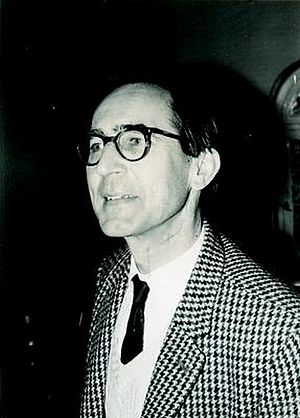David George Kendall facts for kids
Quick facts for kids
David George Kendall
|
|
|---|---|
 |
|
| Born | 15 January 1918 Ripon, West Riding of Yorkshire, England
|
| Died | 23 October 2007 (aged 89) Cambridge, England
|
| Awards | Guy Medal (Silver, 1955) (Gold, 1981) Weldon Memorial Prize (1974) Sylvester Medal (1976) Senior Whitehead Prize (1980) De Morgan Medal (1989) Fellow of the Royal Society, |
| Scientific career | |
| Fields | Probability, statistics, statistical shape analysis |
| Institutions | Magdalen College, Oxford Churchill College, Cambridge |
| Doctoral advisor | M. S. Bartlett |
| Doctoral students | Nicholas Bingham Rollo Davidson John Kingman Robin Sibson Bernard Silverman Richard Tweedie David Vere-Jones David Williams Adrian Baddeley |
David George Kendall FRS (born January 15, 1918 – died October 23, 2007) was a brilliant English mathematician and statistician. He was famous for his work on probability, which is about how likely things are to happen. He also studied "statistical shape analysis" and something called "queueing theory".
Kendall spent most of his working life at two famous universities. He was at the University of Oxford from 1946 to 1962. Then he moved to the University of Cambridge from 1962 until he retired in 1985. During World War II, he worked with another important scientist, M. S. Bartlett.
Contents
Early Life and Education
David George Kendall was born in Ripon, a town in Yorkshire, England. This was on January 15, 1918. He went to Ripon Grammar School when he was younger. After that, he studied at Queen's College, Oxford, and finished his studies there in 1939.
Working During World War II
During World War II, David Kendall used his math skills to help his country. He worked on rockets at a special place called the Projectile Development Establishment. This was part of the Ministry of Supply. His work helped with important projects during the war.
A Career in Mathematics
After the war, in 1946, Kendall started working at Magdalen College, Oxford, which is part of the University of Oxford. He stayed there for many years.
In 1962, he became the very first Professor of Mathematical Statistics at the Statistical Laboratory, University of Cambridge. This was a big achievement! He kept this important job until he retired in 1985. He also became a special fellow at Churchill College, Cambridge.
Kendall's Key Discoveries
David Kendall was a top expert in probability and how to analyze data. He helped create a new field called "statistical shape analysis." This is a way to study and compare the shapes of different objects. He also looked into ley lines, which are imaginary lines connecting ancient sites.
He also came up with something called "Kendall's notation" for queueing theory. This theory helps us understand how queues (like lines at a shop or calls waiting for customer service) work. It helps make things more efficient.
Awards and Recognition
David Kendall received many important awards for his amazing work.
- The Royal Statistical Society gave him the Guy Medal in Silver in 1955.
- Later, in 1981, they gave him the even more prestigious Guy Medal in Gold.
- In 1980, the London Mathematical Society gave him their Senior Whitehead Prize.
- In 1989, he received the De Morgan Medal from the same society.
- He was chosen to be a fellow of the Royal Society in 1964. This is a very high honor for scientists.
Kendall also played a key role in starting the Bernoulli Society in 1975. He was its first president. In 1986, the University of Bath gave him an honorary degree.
Family Life
David Kendall was married to Diana Fletcher. They got married in 1952 and stayed together until his death. They had two sons and four daughters. Some of his children also became successful in their own fields. For example, his son Wilfrid Kendall is a professor of statistics, and his daughter Bridget Kendall is a well-known journalist.

